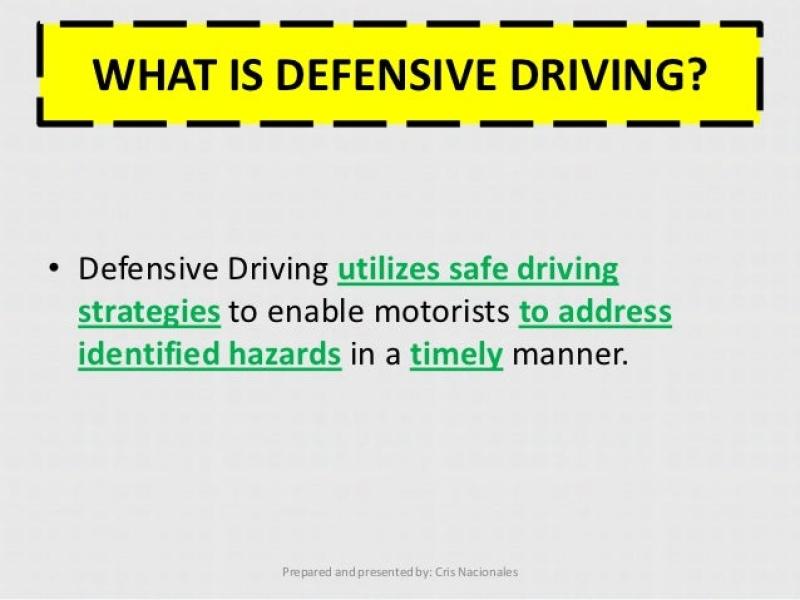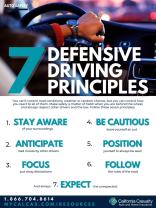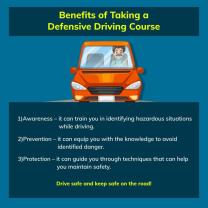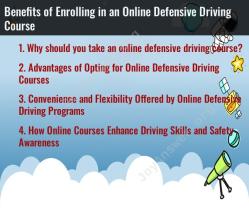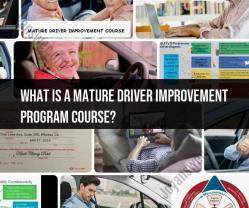What is defensive driving?
Defensive driving is a set of skills and techniques that drivers use to minimize the risks of accidents and enhance safety on the road. The primary goal of defensive driving is to anticipate and respond effectively to potential hazards, ensuring the well-being of the driver, passengers, and others sharing the road. Defensive driving goes beyond following traffic laws and includes proactive strategies to avoid collisions and navigate challenging situations.
Key principles and techniques of defensive driving include:
Anticipating Potential Hazards:
- Defensive drivers remain vigilant and actively scan their surroundings to anticipate potential hazards. This includes identifying potential dangers such as aggressive drivers, pedestrians, bicyclists, and adverse weather conditions.
Maintaining a Safe Following Distance:
- Defensive drivers maintain a safe following distance from the vehicle in front of them. This provides adequate time to react to sudden stops or unexpected maneuvers. The "three-second rule" is a common guideline for maintaining a safe following distance.
Being Mindful of Blind Spots:
- Defensive drivers regularly check their mirrors and are aware of blind spots, the areas around the vehicle not visible through mirrors. Checking blind spots helps prevent collisions when changing lanes or merging.
Adapting to Road Conditions:
- Defensive driving involves adapting to various road conditions, such as wet or slippery surfaces, construction zones, and low visibility. Adjusting driving speed and maintaining control in adverse conditions are essential defensive driving skills.
Minimizing Distractions:
- Defensive drivers minimize distractions to stay focused on the road. This includes avoiding activities such as texting, talking on the phone, eating, or engaging in other distractions that can compromise attention.
Obeying Traffic Laws:
- While defensive driving involves proactive measures, it also includes strict adherence to traffic laws and regulations. Following speed limits, obeying traffic signals, and yielding the right of way contribute to overall road safety.
Using Turn Signals:
- Defensive drivers use turn signals to communicate their intentions to other road users. Signaling helps prevent misunderstandings and enhances predictability on the road.
Remaining Calm and Patient:
- Defensive drivers maintain a calm and patient demeanor, even in challenging situations. Responding to road rage or aggressive behavior with patience and restraint helps avoid escalation and potential conflicts.
Avoiding Tailgating:
- Tailgating, or following the vehicle in front too closely, increases the risk of rear-end collisions. Defensive drivers keep a safe distance to allow for proper reaction time.
Taking Evasive Action When Necessary:
- In certain situations, defensive drivers may need to take evasive action to avoid a collision. This can include steering away from a potential hazard, braking decisively, or executing an emergency maneuver.
Staying Sober and Alert:
- Defensive driving includes maintaining sobriety and alertness. Driving under the influence of alcohol or drugs impairs judgment and reaction time, increasing the risk of accidents.
Defensive driving courses are available to help drivers enhance their skills and knowledge of safe driving practices. These courses often provide additional insights into defensive driving techniques, collision prevention, and strategies for handling challenging situations on the road. Completing a defensive driving course may also lead to insurance discounts in some cases.
By incorporating these defensive driving principles into their habits, drivers contribute to a safer and more secure driving environment for everyone on the road.
Exploring the Concept and Importance of Defensive Driving:
Defensive driving goes beyond simply knowing the rules of the road. It's a proactive approach to driving that prioritizes minimizing risk and anticipating potential dangers. While following traffic laws is essential, defensive driving takes it a step further by emphasizing:
- Constant awareness: Actively scanning your surroundings and anticipating the actions of other drivers and pedestrians.
- Safe space cushion: Maintaining adequate distance from other vehicles to react to unexpected situations.
- Smooth and predictable actions: Avoiding erratic maneuvers and signaling intentions clearly.
- Hazard recognition and avoidance: Identifying potential dangers and taking proactive measures to avoid accidents.
- Defensive mindset: Cultivating a patient and cautious attitude, avoiding distractions, and prioritizing safety over speed or aggression.
The importance of defensive driving is undeniable:
- Reduces accident rates: By anticipating hazards and minimizing risks, defensive drivers drastically decrease their chances of being involved in collisions.
- Improves personal safety: Defensive driving protects not only yourself but also other drivers, passengers, and pedestrians.
- Promotes safer roads: When defensive driving practices become widespread, the overall driving environment becomes safer for everyone.
- Reduces insurance costs: Many insurance companies offer discounts for drivers who complete defensive driving courses, reflecting the reduced risk they pose.
- Boosts confidence and peace of mind: Knowing you're proactively minimizing risks can increase your confidence behind the wheel and reduce driving anxiety.
Techniques and Strategies in Defensive Driving:
Here are some key techniques and strategies for becoming a defensive driver:
- Scan your surroundings: Continuously check your mirrors, blind spots, and all sides of the road for potential hazards.
- Maintain a safe distance: Leave ample space between yourself and other vehicles, considering weather conditions and speed.
- Avoid distractions: Put your phone away, don't eat or drink while driving, and minimize loud music or conversations.
- Signal clearly and predictably: Use turn signals early and consistently to indicate your intentions to other drivers.
- Be cautious in intersections: Approach intersections with vigilance, anticipate other drivers' actions, and never assume right of way.
- Drive in appropriate weather conditions: Adjust your speed and driving behavior based on visibility, rain, snow, or other weather factors.
- Yield to pedestrians and cyclists: Be particularly observant and give right of way to pedestrians and cyclists.
- Stay calm and avoid road rage: Maintain a calm and patient attitude, don't engage in aggressive driving, and avoid reacting negatively to other drivers' mistakes.
- Continually refresh your knowledge: Take refresher courses or revisit defensive driving techniques periodically to stay sharp.
Benefits of Defensive Driving Courses for Road Safety:
Formal defensive driving courses offer valuable benefits beyond simply learning techniques:
- Structured learning: Courses provide a comprehensive and organized framework for understanding and practicing defensive driving principles.
- Professional instruction: Qualified instructors offer guidance, answer questions, and provide personalized feedback.
- Interactive experiences: Many courses utilize simulations, videos, and practical exercises to solidify knowledge and build skills.
- Certification and recognition: Successful completion of a course often leads to a certificate or insurance discount, demonstrating your commitment to safety.
- Community and support: Courses can connect you with other defensive drivers, fostering a shared commitment to road safety.
Investing in a defensive driving course is an investment in yourself and your community. By equipping yourself with the knowledge and skills to navigate the road safely and proactively, you contribute to a safer driving environment for everyone.
I hope this information provides a comprehensive overview of defensive driving and its importance. Feel free to ask any further questions you may have about specific techniques, course recommendations, or the impact of defensive driving on road safety.
